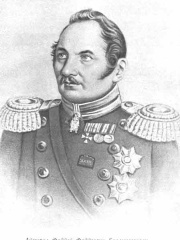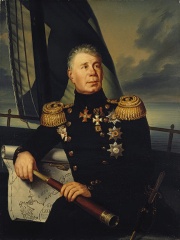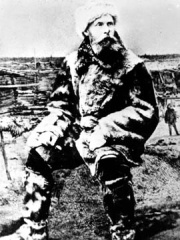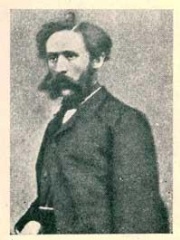



The Most Famous
EXPLORERS from Estonia
Top 4
The following people are considered by Pantheon to be the most legendary Estonian Explorers of all time. This list of famous Estonian Explorers is sorted by HPI (Historical Popularity Index), a metric that aggregates information on a biography's online popularity.

1. Fabian Gottlieb von Bellingshausen (1778 - 1852)
With an HPI of 72.70, Fabian Gottlieb von Bellingshausen is the most famous Estonian Explorer. His biography has been translated into 55 different languages on wikipedia.
Faddey Faddeyevich Bellingshausen or Fabian Gottlieb Benjamin von Bellingshausen (20 September [O.S. 9 September] 1778 – 25 January [O.S. 13 January] 1852) was a Russian cartographer, explorer, and naval officer of Baltic German descent, who attained the rank of admiral. He participated in the first Russian circumnavigation of the globe, and subsequently became a leader of another circumnavigation expedition that discovered the continent of Antarctica. Like Otto von Kotzebue and Adam Johann von Krusenstern, Bellingshausen belonged to a cohort of prominent Baltic German navigators which helped Russia launch its naval expeditions. Bellingshausen was born on the island of Saaremaa (Ösel), to the Bellingshausen family. He started his service in the Russian Baltic Fleet, and after distinguishing himself joined the first Russian circumnavigation of the Earth in 1803–1806, serving on the merchant ship Nadezhda under the captaincy of Adam Johann von Krusenstern. After the journey, he published a collection of maps of the newly explored areas and islands of the Pacific Ocean. Subsequently, he commanded several ships of the Baltic and Black Sea Fleets. As a prominent cartographer, Bellingshausen was appointed to command the Russian circumnavigation of the globe in 1819–1821, intended to explore the Southern Ocean and to find land in the proximity of the South Pole. Mikhail Lazarev prepared the expedition and was made Bellingshausen's second-in-command and the captain of the sloop Mirny, while Bellingshausen himself commanded the sloop Vostok. During this expedition, Bellingshausen and Lazarev became the first explorers to see the land of Antarctica on 27 January 1820 (New Style), disproving James Cook's contention that it was impossible to find land in the southern ice-fields. They circumnavigated the continent twice and never lost each other from view. The expedition discovered and named Peter I, Zavodovski, Leskov, Alexander, and Visokoi Islands, the Antarctic Peninsula, and made other discoveries in the tropical waters of the Pacific. Made captain-commodore on his return, Bellingshausen participated in the Russo-Turkish War of 1828–1829. Promoted to vice admiral, he again served in the Baltic Fleet in the 1830s. From 1839, he was a military governor of Kronstadt, and gained the rank of admiral in 1843. In 1831, he published the book on his Antarctic travels, called Double Investigation of the Southern Polar Ocean and the Voyage Around the World.

2. Adam Johann von Krusenstern (1770 - 1846)
With an HPI of 65.23, Adam Johann von Krusenstern is the 2nd most famous Estonian Explorer. His biography has been translated into 36 different languages.
Adam Johann von Krusenstern (Russian: Ива́н Фёдорович Крузенште́рн, romanized: Ivan Fyodorovich Kruzenshtern; 10 October 1770 – 12 August 1846) was a Russian admiral and explorer of Swedish and Baltic German descent, who led the first Russian circumnavigation of the Earth in 1803–1806.

3. Eduard von Toll (1858 - 1902)
With an HPI of 59.12, Eduard von Toll is the 3rd most famous Estonian Explorer. His biography has been translated into 24 different languages.
Eduard Gustav Freiherr von Toll (Russian: Эдуа́рд Васи́льевич Толль, romanized: Eduárd Vasíl'evič Toll'; 14 March [O.S. 2 March] 1858 – disappeared 26 October 1902), better known in Russia as Eduard Vasilyevich Toll and often referred to as Baron von Toll, was a Russian geologist and Arctic explorer. He led the Russian polar expedition of 1900–1902 in search of the legendary Sannikov Land, a phantom island purported to lie off Russia's Arctic coast. During the expedition, Toll and a small party of explorers disappeared from Bennett Island, and their fate remains unknown to this day.

4. Richard Maack (1825 - 1886)
With an HPI of 55.88, Richard Maack is the 4th most famous Estonian Explorer. His biography has been translated into 16 different languages.
Richard Otto Maack (Russian: Ричард Карлович Маак, romanized: Richard Karlovich Maak; 4 September 1825 – 25 November 1886) was a Russian naturalist, geographer, and anthropologist. He is most known for his exploration of the Russian Far East and Siberia, particularly the Ussuri and Amur River valleys. He wrote some of the first scientific descriptions of the natural history of remote Siberia and collected many biological specimens, many of which were original type specimens of previously unknown species. Ethnically Maack was a Baltic German from Estonia; however, the Russian Empire controlled this country during his lifetime. He was a member of the Siberian branch of the Russian Geographical Society.
People
Pantheon has 4 people classified as Estonian explorers born between 1770 and 1858. Of these 4, none of them are still alive today. The most famous deceased Estonian explorers include Fabian Gottlieb von Bellingshausen, Adam Johann von Krusenstern, and Eduard von Toll.
Deceased Estonian Explorers
Go to all RankingsFabian Gottlieb von Bellingshausen
1778 - 1852
HPI: 72.70
Adam Johann von Krusenstern
1770 - 1846
HPI: 65.23
Eduard von Toll
1858 - 1902
HPI: 59.12
Richard Maack
1825 - 1886
HPI: 55.88
Overlapping Lives
Which Explorers were alive at the same time? This visualization shows the lifespans of the 4 most globally memorable Explorers since 1700.

